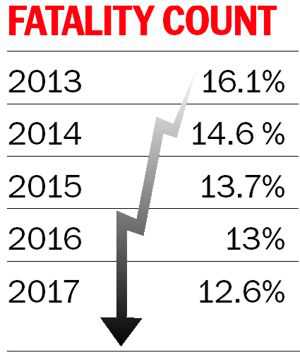12.6% people died at hands of quacks in 2017: Report
Bhartesh Singh Thakur
Tribune News Service
Chandigarh, July 15
About 12.6 per cent of patients who had died during treatment in 2017 in Haryana had last consulted quacks, indicating the sorry state of affairs of health services in the state.
This has been brought out in the latest Sample Registration System (SRS) report taken out by the Registrar General and Census Commissioner of India. Every year, the Registrar General and Census Commissioner of India brings out the SRS report based on the Census.
The latest report says that in rural areas of Haryana, 12.8 per cent of the deaths took place at the hands of quacks in 2017, while the figure was 12 per cent in urban areas.
Haryana’s figure is higher as compared with neighbouring states. In Himachal Pradesh, 5 per cent of deaths were at the hands of quacks in 2017. And in Punjab, the percentage was 3.
Though Jammu and Kashmir has a figure of 11.9 per cent and Delhi has 10.2 per cent of such deaths.
The national average of deaths at the hands of quacks was 19.8 per cent; the highest is in Odisha (37.2 per cent).
In 2016, 13 per cent of people had died at the hands of quacks in Haryana. A year before that, the percentage was 13.7.
“Haryana lacks round-the-clock health facilities. There are quacks in most of villages and slums. They either operate from their clinics or visit patients at their homes. There are ayurvedic and homeopathic practitioners who practise allopathy. Chief Medical Officers (CMOs) in the state must take action against quacks,” said Prof Aswini Kumar Nanda from the Centre for Research in Rural and Industrial Development, who undertakes research and evaluation of health services in Punjab, Haryana and Rajasthan on behalf of the Union Ministry of Health and Family Welfare.
When contacted, government officials refused to comment on the report. But a SRS official said that with the increase in health facilities, the figure was dropping in Haryana but it was still on the higher side. In 2017, 50.8 per cent of total deaths in Haryana took place before qualified medical professionals, while 20.8 per cent of deaths took place in government hospitals and 15.8 per cent in private ones. “The data is based on response from people collected via a door-to-door survey,” said an investigator working with SRS in Chandigarh.
Targeting villagers
Haryana lacks round-the-clock health facilities. There are quacks in most of the villages and slums. Chief Medical Officers in the state must take action against quacks. — Prof Aswini Kumar Nanda, Centre for Research in Rural and Industrial Development









